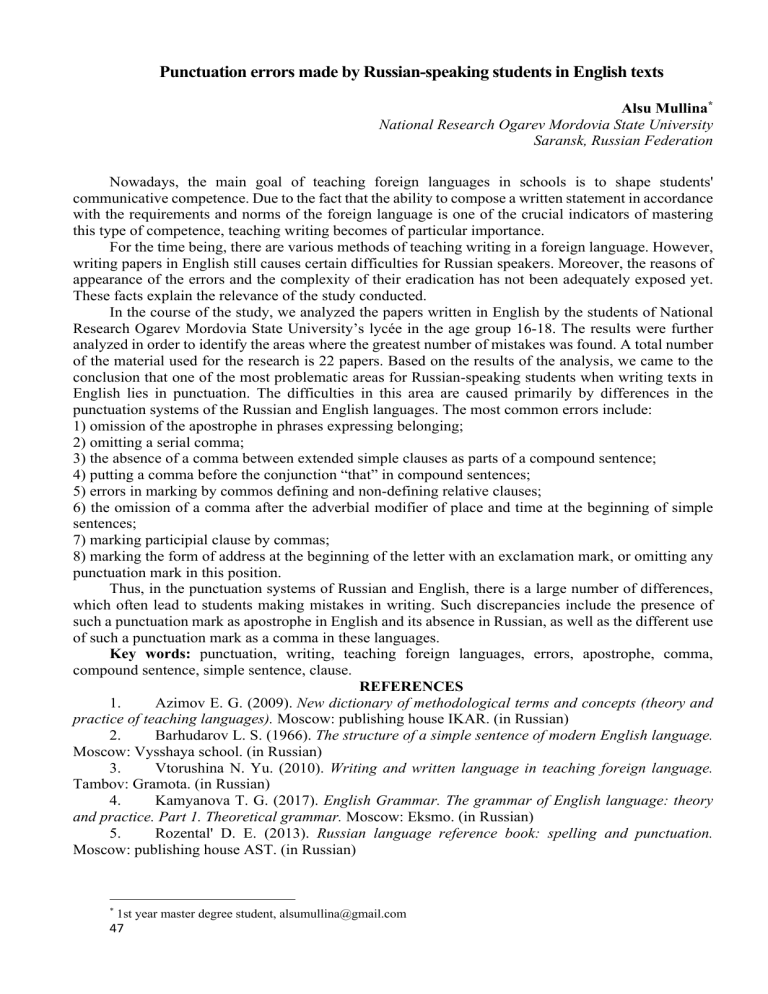
Punctuation errors made by Russian-speaking students in English texts
Alsu Mullina*
National Research Ogarev Mordovia State University
Saransk, Russian Federation
Nowadays, the main goal of teaching foreign languages in schools is to shape students'
communicative competence. Due to the fact that the ability to compose a written statement in accordance
with the requirements and norms of the foreign language is one of the crucial indicators of mastering
this type of competence, teaching writing becomes of particular importance.
For the time being, there are various methods of teaching writing in a foreign language. However,
writing papers in English still causes certain difficulties for Russian speakers. Moreover, the reasons of
appearance of the errors and the complexity of their eradication has not been adequately exposed yet.
These facts explain the relevance of the study conducted.
In the course of the study, we analyzed the papers written in English by the students of National
Research Ogarev Mordovia State University’s lycée in the age group 16-18. The results were further
analyzed in order to identify the areas where the greatest number of mistakes was found. A total number
of the material used for the research is 22 papers. Based on the results of the analysis, we came to the
conclusion that one of the most problematic areas for Russian-speaking students when writing texts in
English lies in punctuation. The difficulties in this area are caused primarily by differences in the
punctuation systems of the Russian and English languages. The most common errors include:
1) omission of the apostrophe in phrases expressing belonging;
2) omitting a serial comma;
3) the absence of a comma between extended simple clauses as parts of a compound sentence;
4) putting a comma before the conjunction “that” in compound sentences;
5) errors in marking by commos defining and non-defining relative clauses;
6) the omission of a comma after the adverbial modifier of place and time at the beginning of simple
sentences;
7) marking participial clause by commas;
8) marking the form of address at the beginning of the letter with an exclamation mark, or omitting any
punctuation mark in this position.
Thus, in the punctuation systems of Russian and English, there is a large number of differences,
which often lead to students making mistakes in writing. Such discrepancies include the presence of
such a punctuation mark as apostrophe in English and its absence in Russian, as well as the different use
of such a punctuation mark as a comma in these languages.
Key words: punctuation, writing, teaching foreign languages, errors, apostrophe, comma,
compound sentence, simple sentence, clause.
REFERENCES
1.
Azimov E. G. (2009). New dictionary of methodological terms and concepts (theory and
practice of teaching languages). Moscow: publishing house IKAR. (in Russian)
2.
Barhudarov L. S. (1966). The structure of a simple sentence of modern English language.
Moscow: Vysshaya school. (in Russian)
3.
Vtorushina N. Yu. (2010). Writing and written language in teaching foreign language.
Tambov: Gramota. (in Russian)
4.
Kamyanova T. G. (2017). English Grammar. The grammar of English language: theory
and practice. Part 1. Theoretical grammar. Moscow: Eksmo. (in Russian)
5.
Rozental' D. E. (2013). Russian language reference book: spelling and punctuation.
Moscow: publishing house AST. (in Russian)
*
1st year master degree student, alsumullina@gmail.com
47
